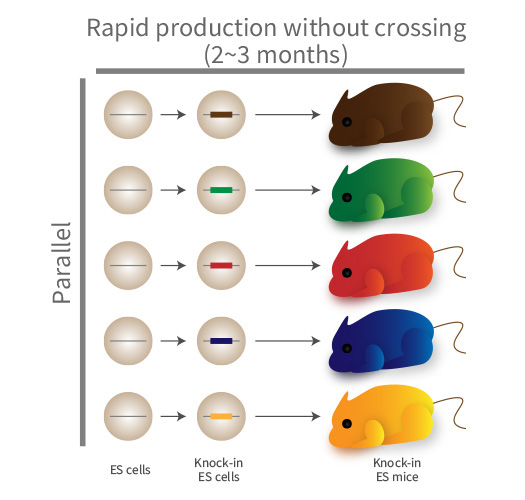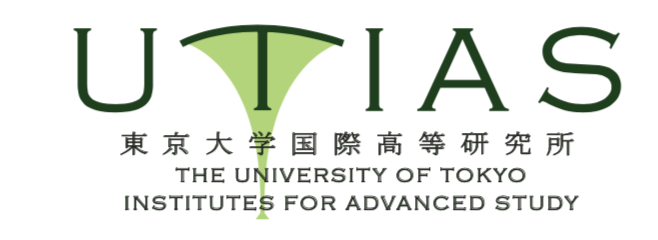
ES-Mouse/Virus Core Core Manager
Project Associate Professor
Development of Next-Generation Mammalian Genetics
Research
For elucidation of the mechanisms underlying higher-order biological phenomena, e.g., intelligence and mental disorders in humans, comprehensive identification and quantitative analysis of human gene-networks and cellular circuits are required. Reverse genetics is one of the powerful methods for this elucidation. However, mouse genetics is generally low throughput, due to the need for repeat crossing of chimeras/mosaics to produce genetically modified mice, and hence analyzing many genes/cells is difficult. Recently, we have established an efficient method to produce mutant mice without crossing. We are developing a method to elucidate human biological phenomena by applying the high-throughput production method of our mutant mice to genetically humanized mice in which mouse genes are replaced with human genes.

Publications
Ukai H, Sumiyama K, Ueda HR. Next-generation human genetics for organism-level systems biology. Current Opinion in Biotechnology. 2019. 58:137-145.
Ukai H, Kiyonari H, Ueda HR. Embryonic stem cell-mouse protocol to produce knock-in (KI) mice in a single generation. Nature Protocols 2017 DOI 10.1038/nprot.2017.110
*Ode KL, *Ukai H, *Susaki EA, Narumi R, Matsumoto K, Hara J, Koide N, Abe T, Kanemaki MT, Kiyonari H, Ueda HR. Knockout-Rescue Embryonic Stem Cell-Derived Mouse Reveals Circadian-Period Control by Quality and Quantity of CRY1. Molecular Cell 2017 Jan 5;65(1):176-190. * These authors contributed equally to this work.
Susaki EA, Ukai H, Ueda HR. Next-generation mammalian genetics toward organism-level systems biology. npj. Syst. Biol. Appl. 2017 3, article number 15.
Ukai H. and Ueda HR. Systems Biology of Mammalian Circadian Clock. Annual Review of Physiology 2010 72:579-603.
*Isojima Y, *Nakajima M, *Ukai H, Fujishima H, Yamada RG, Masumoto KH, Kiuchi R, Ishida M, Ukai-Tadenuma M, Minami Y, Kito R, Nakao K, Kishimoto W, Yoo SH, Shimomura K, Takao T, Takano A, Kojima T, Nagai K, Sakaki Y, Takahashi JS, Ueda HR. CKIepsilon/delta-dependent phosphorylation is a temperature-insensitive, period-determining process in the mammalian circadian clock. Proc. Natl. Acad. Sci. USA. 2009 Sep 15;106(37):15744-9. * These authors contributed equally to this work.
*Ukai H, *Kobayashi TJ, Nagano M, Masumoto KH, Sujino M, Kondo T, Yagita K, Shigeyoshi Y, Ueda HR. Melanopsin-dependent photo-perturbation reveals desynchronization underlying the singularity of mammalian circadian clocks. Nature Cell Biology 2007 Nov;9(11):1327-34. * These authors contributed equally to this work.
*Sato TK, *Yamada RG, *Ukai H, Baggs JE, Miraglia LJ, Kobayashi TJ, Welsh DK, Kay SA, Ueda HR, Hogenesch JB. Feedback repression is required for mammalian circadian clock function. Nature Genetics 2006 Mar;38(3):312-9. * These authors contributed equally to this work.
Biography
I was a postdoctoral researcher at the National Institute of Radiological Sciences after earning a Ph.D. from the Graduate University for Advanced Studies. I developed the technologies for genome-scale analysis and discovered a new oncogenic mutation by using the technologies. Next, at the RIKEN CDB, I developed technologies for cellular-level systems biology using a circadian clock system as a model system of a complex phenomenon and elucidated the mechanism of the complex phenomenon such as the singularity behaviour of the circadian clock. After moved to the RIKEN QBiC, I started to develop the technologies toward organism-level systems biology to elucidate the mechanism of the higher-order biological phenomena, and have established an efficient method to produce mutant mice within a single generation. In my current position, by using my technology, I provide mutant mice and virus for researchers and also develop special mouse lines intended as common resources for the IRCN.


